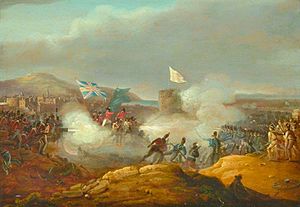Siege of Tarifa (1812) facts for kids
Quick facts for kids Siege of Tarifa (1812) |
|||||||
|---|---|---|---|---|---|---|---|
| Part of the Peninsular War | |||||||
 Royal Irish Fusiliers repel a French assault |
|||||||
|
|||||||
| Belligerents | |||||||
| Commanders and leaders | |||||||
| Strength | |||||||
| 8,000–10,400 16 guns |
2,300–4,500 26 guns |
||||||
| Casualties and losses | |||||||
| 600–680 killed, wounded or captured 9–14 guns lost |
68–150 killed, wounded or captured | ||||||
The Siege of Tarifa was an important battle that took place from December 19, 1811, to January 5, 1812. It was part of the Peninsular War, which was itself a part of the larger Napoleonic Wars. In this siege, a French army led by General Jean François Leval tried to capture the town of Tarifa in Spain.
Tarifa was defended by a mix of Spanish and British soldiers. They were commanded by Spanish General Francisco Copons and British Colonel John Byrne Skerrett. Tarifa is located at the very southern tip of Spain, about 65 miles (105 km) southeast of Cadiz. This battle was a key moment in the Peninsular War.
Contents
Who Fought in the Siege?
French and Polish Forces
The French army was led by General Jean François Leval. He commanded a large force of about 8,000 soldiers. They also had 16 powerful siege cannons. His troops included many different French infantry regiments.
Leval's army also had soldiers from Poland. These Polish troops were part of the 7th and 9th Infantry Regiments. The French also had cavalry, which are soldiers who fight on horseback.
Spanish and British Defenders
The defenders of Tarifa were led by Spanish General Francisco Copons. They had fewer soldiers, about 3,000 in total, but they had 26 cannons. The Spanish brigade included soldiers from the Irlanda and Cantabria Infantry Regiments. They also had sharpshooters, gunners, and a few cavalrymen.
British Colonel John Byrne Skerrett led the British soldiers. His brigade included several infantry battalions, like the 47th, 82nd, and 87th Foot regiments. They also had riflemen, cavalry from the King's German Legion, and an artillery battery.
How Did the Siege Unfold?
French Attack Begins
The French army began their attack on December 19. They pushed back the defenders' outer posts. Then, they looked at the town to decide where to attack the walls. They saw that the high ground to the east looked like a good spot.
On December 22, the French started digging trenches. By December 29, their 16-pounder cannons were ready to fire. It only took a few hours for the town walls to break down. This created a large opening, called a breach.
Defending Tarifa's Walls
The small, walled town of Tarifa seemed very hard to defend. Higher ground nearby made it easy for the French to shoot cannons at the walls. Colonel Skerrett thought they should give up and leave by ship.
However, Captain Charles Felix Smith of the Royal Engineers disagreed. He noticed that the ground inside the walls was much lower. Also, a deep, narrow river flowed through the town. These features would make it very dangerous for the French to attack. General Campbell, the Governor of Gibraltar, also ordered the ships to stay away. This meant the defenders could not leave.
Captain Smith had prepared special defenses inside the town. There was a 14-foot drop inside the broken wall, which would trap French soldiers. Every house near the breach was prepared for fighting. Soldiers could shoot from holes in the walls, and new defenses were built to stop the enemy. All the broken pieces of the wall were cleared away, even while the French were still firing.
The French offered terms for surrender, but the defenders refused to give up.
The Main Assault and Retreat
On the night of December 29-30, there was very heavy rain. The strong flood of water bent the gate that protected the river entrance. The defenders quickly repaired their defenses before the French attacked at dawn.
French soldiers, called Grenadiers, tried to enter through the river gate. But the gate held, and the 87th Regiment fired heavily at them. The French then tried to attack the main breach in the wall. They met more strong fire and had to retreat back to the river bed. A cannon on a tower fired at them, making them hide among their dead and wounded. Eventually, they retreated back to their camp.
This was the only major attack the French made. The weather got much worse for several days. Heavy rain damaged the French cannons and trenches. On the night of January 4, 1812, the defenders heard the French pulling back. The next morning, the Spanish and British soldiers attacked. They forced the French to retreat, leaving their siege equipment behind.
What Happened After the Siege?
General Jean François Leval withdrew his army after his attack failed. Many of his soldiers also became sick. The ground was too muddy for the French to take their heavy cannons with them. So, they destroyed most of their cannons and left them behind.
Historian William Francis Patrick Napier praised the defense of Tarifa. He said that Captain Charles Smith of the Engineers deserved much of the credit. Smith's clever planning helped save the town.
Captain Charles Felix Smith continued to fight in many more battles. He later became a lieutenant general and was knighted. General Francisco Copons also fought in many more battles with the British.
The French never returned to Tarifa. Their larger siege of Cadiz was given up in August 1812. Over the next year, the French army slowly retreated all the way back to France.
Images for kids



